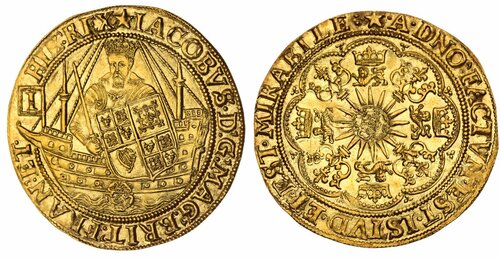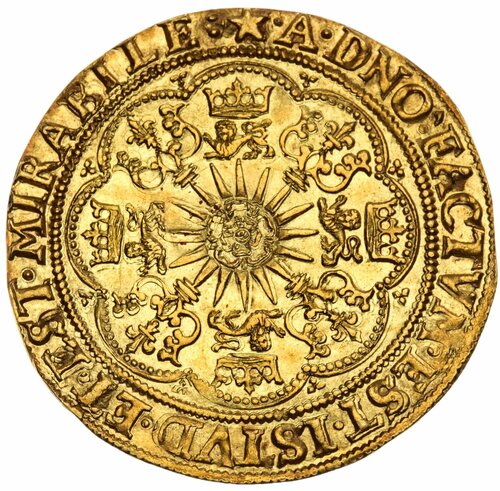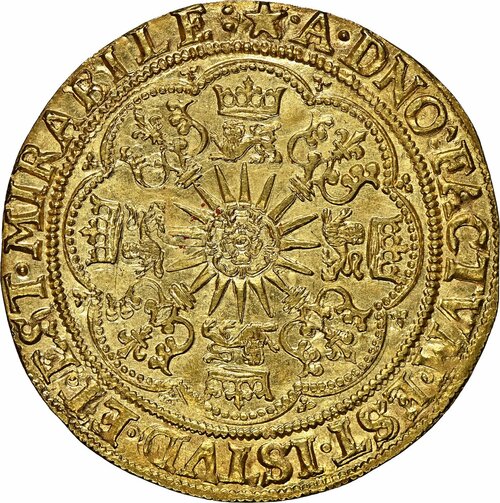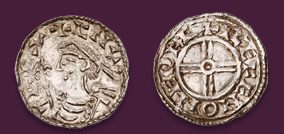Auction: 21064 - The Horace Hird Collection of Tudor, Stuart and Commonwealth Coins and Patterns
Lot: 34
MS64 STAR | James I (1603-1625), Second Coinage, 'Ship Noble' or Spur Ryal, 1611-1612, Tower, (m.m.) IACOBVS • D .' G .' MAG .' BRIT .' FRAN .' ET • | HIB .' REX, King holding sword and Royal shield, standing three-quarters facing in Galleon, double-rose set atop lower of two gun decks, ropes 3/3, I on standard, plain masts either side of King, choppy waters lap below, rev. (m.m.) • A • DNO .' FACTVM • EST • ISTVD • ET • EST • MIRABILE : (the colon over the key), rose upon radiant sun, alternating crowned Leopards and floriate cross terminals in angles, small trefoils in spandrels, 6.76g [104.3grns], 10h, m.m. mullet [over key] (HCN 205; Montagu III, 136 = Murdoch I, 686 = Lingford II, 893 this coin; Rashleigh [1909], 858 = BM 1935.0401.6994 same dies; Schneider II, 12-13, same obverse die; North 2080; Spink 2614), a brighter specimen with a faint hint of doubling to reverse legends, otherwise a truly awe-inspiring example of this classic Stuart rarity, highly befitting of the revered 19th and 20th Century cabinets it has formerly graced, beautifully round with flares of residual lustre, a most captivating extremely fine, of the highest rarity and once thought unique by Montagu and Murdoch, now one of three recorded with this privy mark, and still the finest known either in public or private hands with an outstanding pedigree, in NGC 'Horace Hird' holder, graded MS64* (Cert. #6135299-034)
Provenance
A Lost Parcel from the Celebrated Horace Hird Collection
H M Lingford, Part II, Glendining, 20-21 June 1951, lot 893 - 'in beautiful state and extremely rare' - £200.0.0 [Baldwin for Hird]
The Spink Library copy, annotated by Douglas Liddell, notes simply: 'a lovely specimen' and was evidently sorely missed by Beresford-Jones for whom Spink conducted his underbids.
Murdoch, First Portion, Sotheby's, 31 March 1903, lot 686 - exceedingly fine and believed to be unique with this mint mark - £28.0.0
Montagu, Third Portion, Sotheby's, 13 November 1896, lot 136 - extremely fine and an extremely rare m.m. - £40.0.0 [Spink for Murdoch]
Addington, collection purchased en bloc by Montagu, 1883
'Noble or Rial' - William Forster, Sotheby's, 28-30 May 1868, lot 98 - extremely rare and presumed to be the finest known - £32.0.0 [King for Addington]
James Dodsley Cuff, Sotheby's, 8 June 1854, lot 1112 - very fine and very rare, Sn. p.5 n. 8 - £25.10.0 [Webster for Forster]
This obverse die is one of the most remarkable to be employed in the long and illustrious history of the English coinage. Whilst overpunched pyx marks are frequent during the reigns of the Stuart Kings, typically the refurbished die is re-marked only once, and in very rare instances twice. However in this particular case, the die evidently sunk during the pyx period of the Key (1609-1610), is re-employed not just for the Mullet (1611-1612) issue as seen here, but also for the subsequent Tower, Trefoil and Cinquefoil privy marks, in effect four times, as testified by the Schneider collection. The British Museum also possesses a further unique coin, exhibiting either the tun or possibly book pyx symbol, again from the same obverse die.
Obvious conclusions can be drawn about the serviceable life of the die, which must have been at least four years and perhaps as long as seven. For economic historians and numismatists alike this is a clear indication of the extremely short supply of Ship Nobles struck for circulation between 1611 and 1615, reflective of the shortage of bullion during this period, and tantalising evidence for the revaluation of the gold specie in November 1611, commoditising this coin at 16 Shillings and Sixpence.
Subject to 20% VAT on Buyer’s Premium. For more information please view Terms and Conditions for Buyers.
Sold for
£260,000
Starting price
£40000













